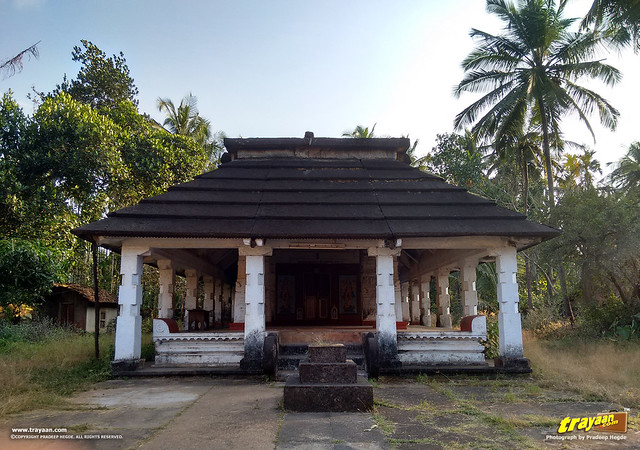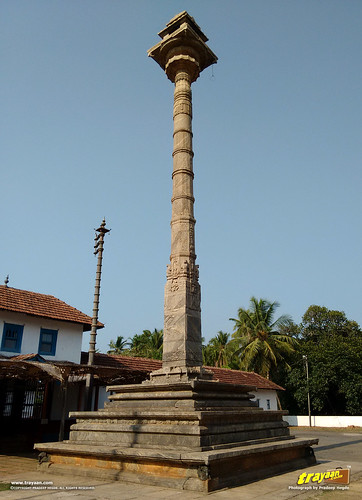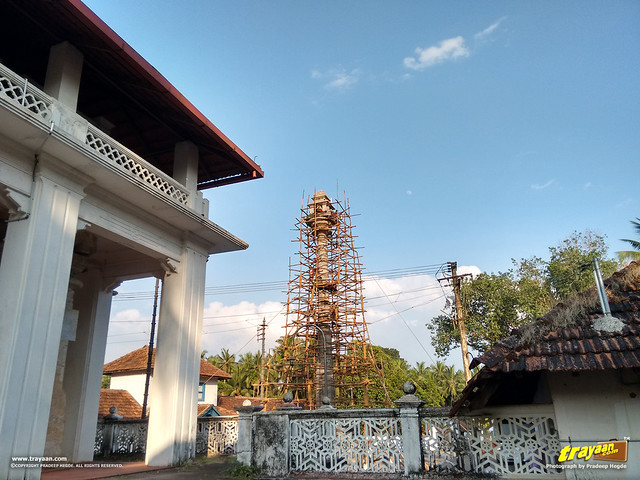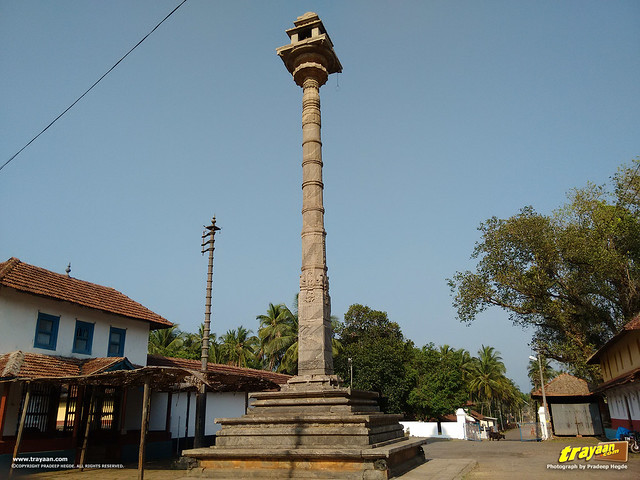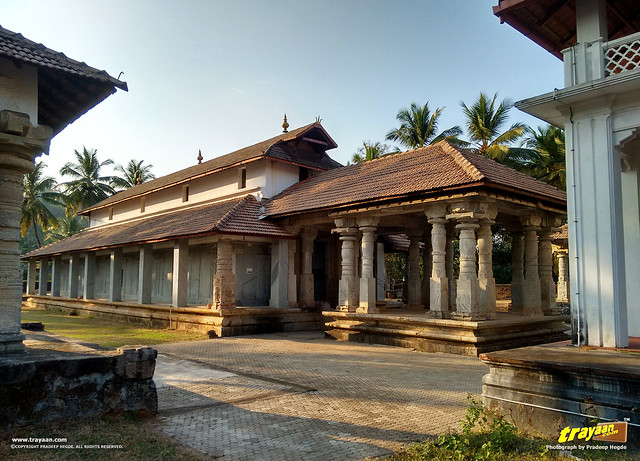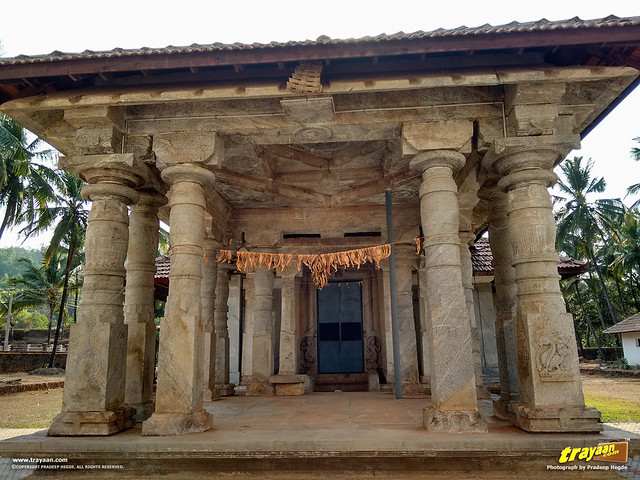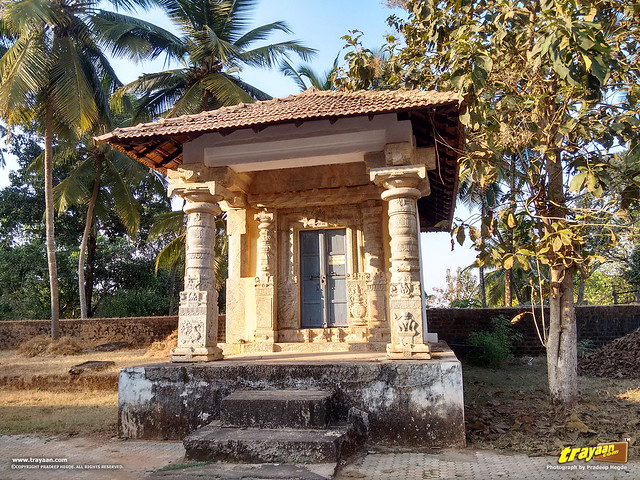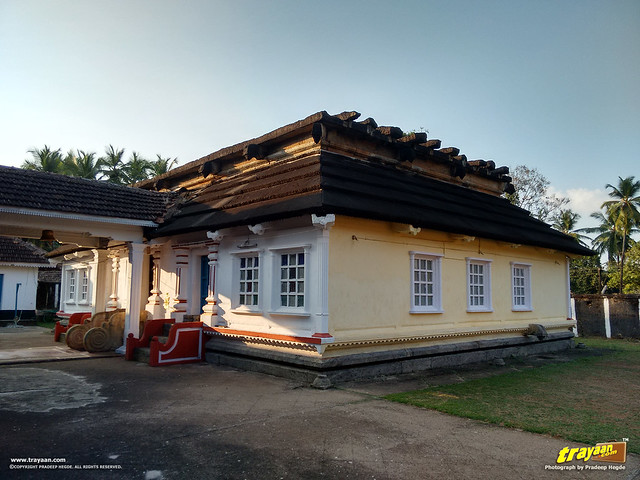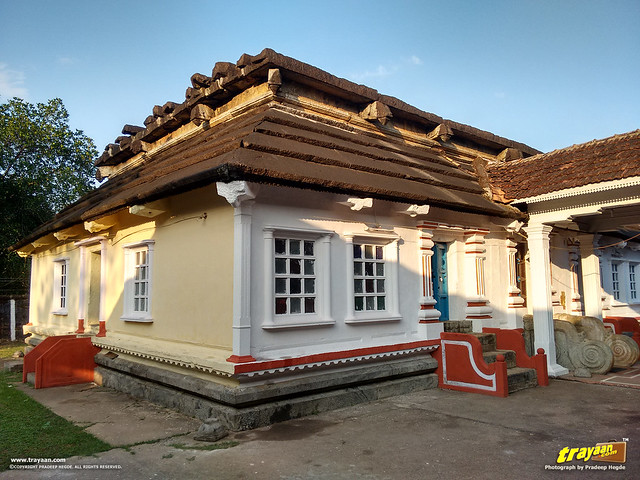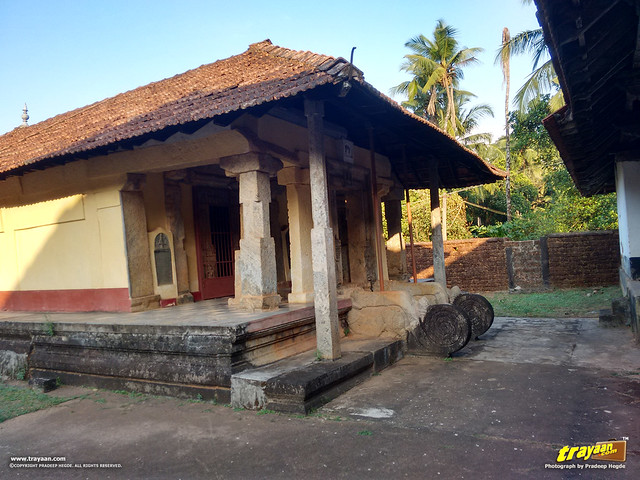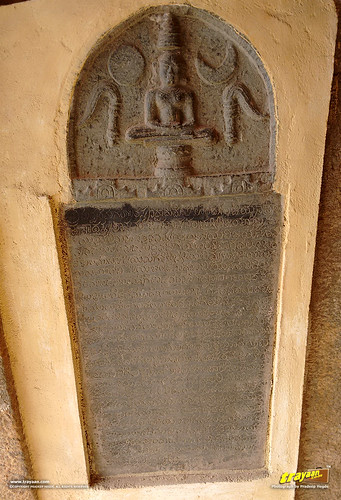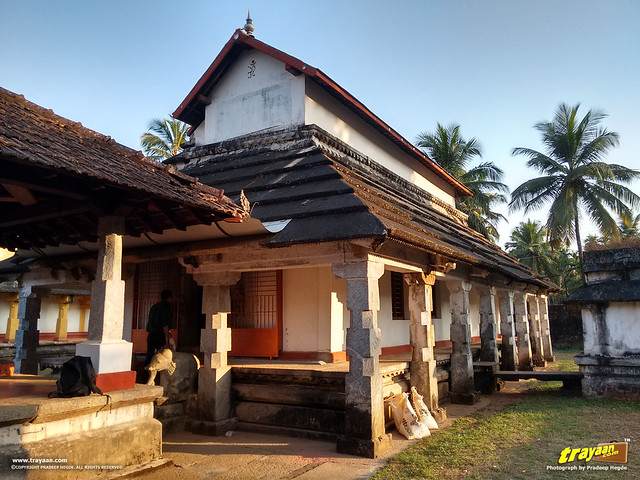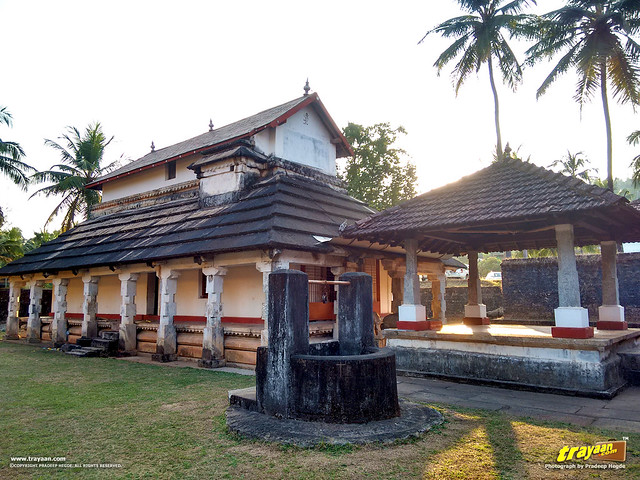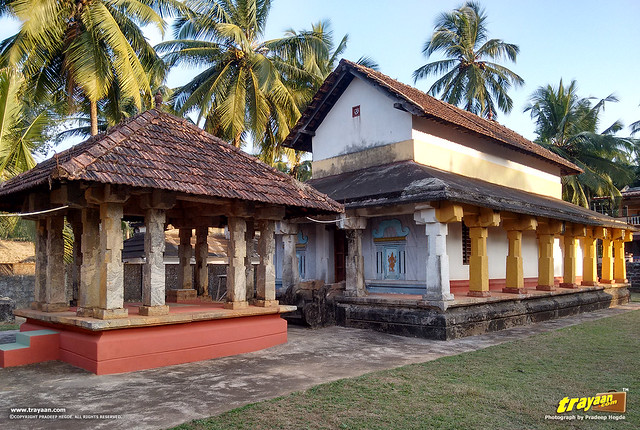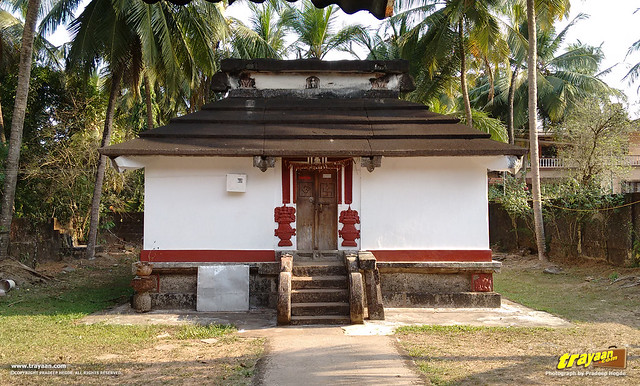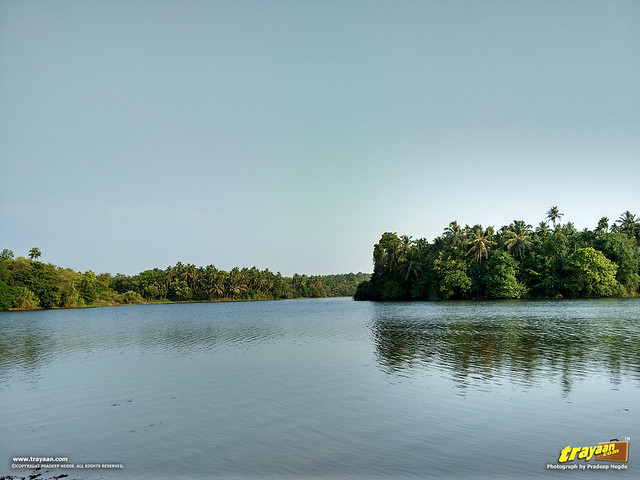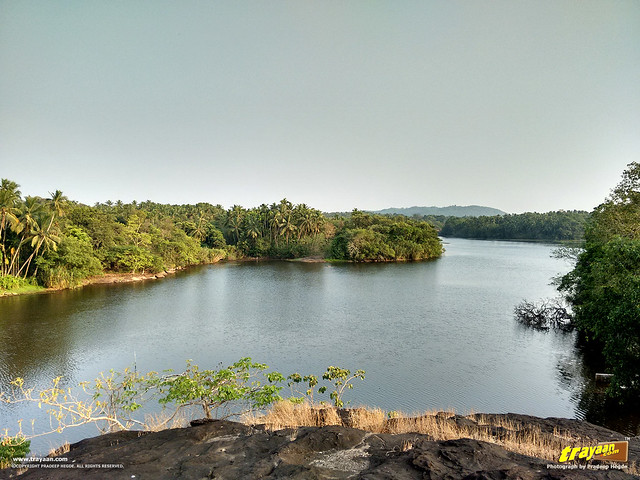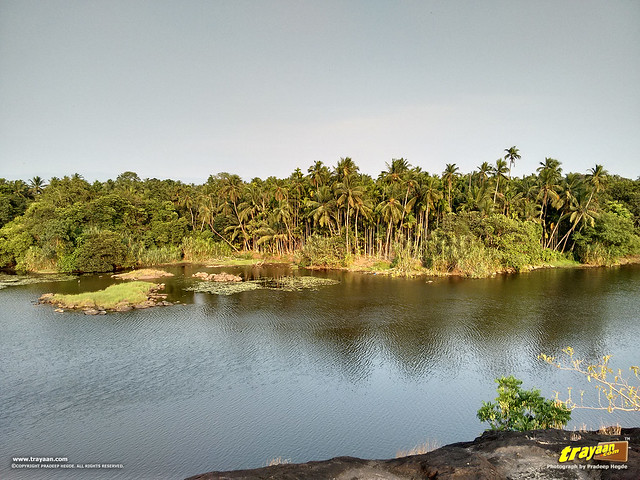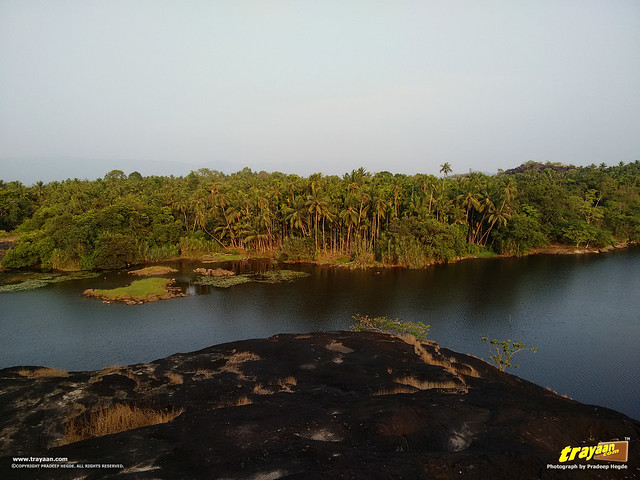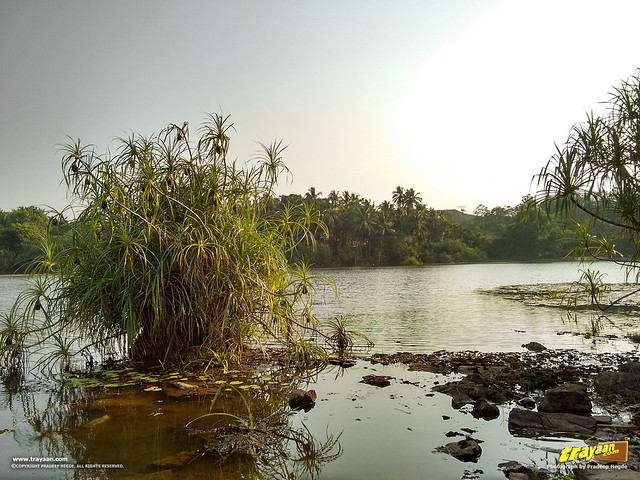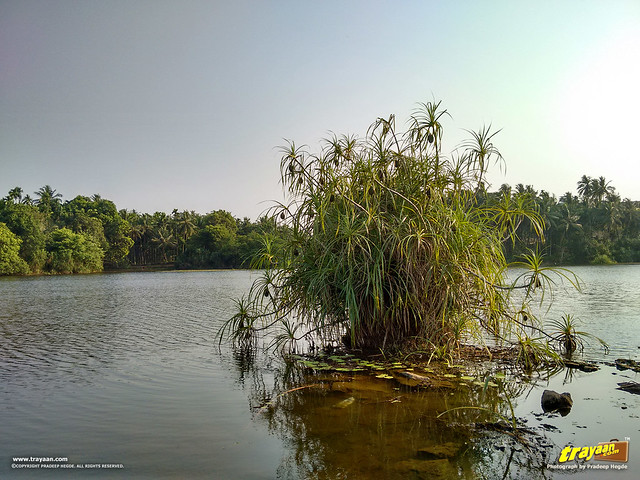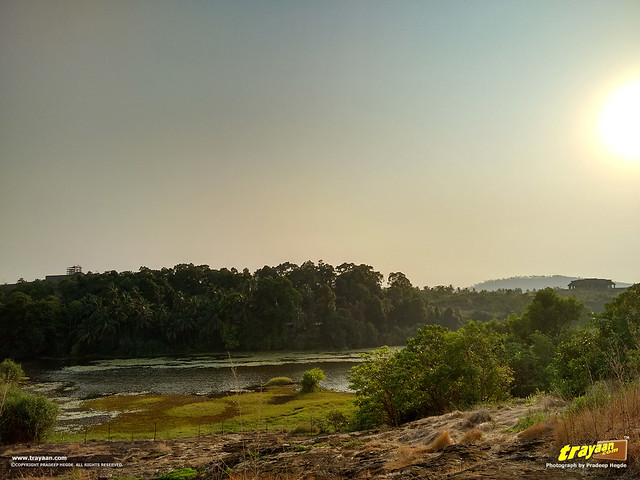The famed Jain heritage centre in Udupi district, Karnataka.
Continuing from the last part, here is the rest of our trip to Karkala, featuring the great Manasthambha before Shri Neminatha Mandir at Hiriyangadi, and also including Shri Anantapadmanabha Temple and Ramasamudra lake of Karkala.

Great Manasthambha of Hiriyangadi, before the entrance to the Hallara Basadi (right) and the entrance to Neminatha Basadi Jain Temple
Karkala town in Udupi district of Karnataka is home to several historically significant hundreds of years old Jain temples or basadis. Many historical structures like the great Manasthambha before the Neminatha Mandir at Hiriyangadi, stand in Karkala as wonderful examples of art and architecture.
Jump to:
| Place Details & Brief History | Our Karkala Trip - Part 2 | Other Historical Basadis of Karkala | Anantapadmanabha Temple | Ramasamudra Lake
| Tips for Travellers | Getting There & Transportation | Food & Accommodations | Best times to visit
| Location Map | Get Directions | Nearby Attractions
| Place Details & Brief History | Our Karkala Trip - Part 2 | Other Historical Basadis of Karkala | Anantapadmanabha Temple | Ramasamudra Lake
| Tips for Travellers | Getting There & Transportation | Food & Accommodations | Best times to visit
| Location Map | Get Directions | Nearby Attractions
Karkala is home to several hundreds of years old Jain and Hindu Temples that stand to date as an evidence of a rich and diverse cultural history of Coastal Karnataka and surrounding regions and their wonderful examples of art and architecture. Some of them are now protected by the Archaeological Survey of India (ASI), like the Ananthapadmanabha temple, built in 1567 CE, the Chathurmukha Basadi, The monolith of Lord Bahubali Gommateshwara and the Manasthamba at Hiriyangadi.
Karkala is one of the places worth visiting if you happen to be at Udupi or Mangalore (now renamed as Mangaluru) on a tour.
Our Karkala Trip - Part 2
Continuing from Part-1 : Chaturmukha Basadis of Karkala, and the Karkala Gommateshwara Monolith, here is the remaining part of our Karkala trip.Other Historical Basadis of Karkala
From Chaturmukha Basadi, on our first Karkala trip, we went searching for more historically significant temples. On the road, near the Anekere Basadi, we found Shravana basadi, with Chandranatha swamy as the main deity. It has a small pillared open hall on the front, with beautifully carved pillars. As other basadis, it has the typical slanted stone shades.Next, we headed to the Neminath Basadi complex, with the great Manasthambha (which means: column of honour), a huge granite pillar at Hiriangadi. These pillars are often found before or beside Jain temples. The manasthambha pillar was installed around the middle of the 15th century by Pandya, the grandson of Bhairava I who had established the control of the Kalasa house over Karkala region for the first time. Measuring 16.5 metre or 54 feet in height, this manasthambha in front of the Neminatha Mandir is one of the protected monuments by the ASI.
Maintenance works were going on that day, so we visited again last month during our visit to the Bahubali Gomateshwara monolith, for a better view of the great Manasthambha!
(Not to be confused with the Neminatha Basadi (also called Neminath Mandir), a 1200 year old Jain temple at Varanga)
The construction of Neminatha mandira is attributed in an inscription of Bhairava I [1]
The Neminatha basadi now stands renovated with new tiles covering up on the outer side. It is attributed as Neminatha Mandir, meaning Neminatha Temple on one of the signboards in the premises. It was closed at the time, and we could not have a look inside.
It has the typical style of the slanted stone roofing but with brick tiles instead of stone slabs, with architecture similar to other basadis such as the Thousand pillared basadi of Moodabidri, but much smaller in size. The caretaker of the Baradi basadi informed us that it was renovated just last year. We do not know how it looked before, but only two beautifully carved pillars on the front look like original rock pillars. They look old and have a slightly worn out look. The rest of the pillars seem new and covered with glazed tiles, as most of the outer walls. The basadi itself does not have any more stone pillars on the outside. The porch on the front has pillars, but a couple of them seem newer as they seem to have a lesser worn out look.
The two shrines on the either sides of the basadi are ornate. They are, Chandranath Swamy Basadi or Eda basadi (meaning left temple) and Adinath Swamy Basadi or Bala Basadi (meaning right temple).
The Neminatha temple surroundings holds five more basadis, in the three enclosures on each side of the manasthambha. A small door leads to them inside their enclosure. They all seem to be functional even now.
While Neminatha Basadi is east-facing, the other Basadis in the complex are not.
On the enclosure towards the right side of the manasthambha, is the Hallara Basadi with Parshwanatha Swamy and Padmawathi Devi as deities. It derives the name Hallara basadi, as it was built by the Hallas. As it contains an idol of goddess Padmavati Devi, who is called as Ammnavaru, it is also called as Ammanavara Basadi. This basadi also has an idol of Goddess Saraswati.
The Hallara basadi was newly painted at the time of our visit. It has flat stone roofing with the typical slanted stone shades. It has a main entrance towards south, with two more doors on either side adjacent to the main door. There is one more entrance towards west, but none towards east.
The other basadi in this enclosure is Gururaya basadi, featuring a Halegannada (Old Kannada) inscription.
To the left of the manasthambha are three more basadis, in an enclosure, all facing towards north. Two are in a sub enclosure in the western side, and one in the eastern side. A wall separates these two sub enclosures. In the western subenclosure, the basadis are smaller in size, but of similar style of architecture. They are the Baradi basadi or Sri Shanthinatha Swami Guru Basadi on the west side of the sub enclosure, and Ananthanath digambar Jain basadi, or the Kallu Basadi on the east side. These were built by the Baradi family.
These temples also feature the typical slanted stone shades, and have an architecture similar to the Neminatha Basadi.
There is one more small basadi in the eastern sub enclosure, called Adinathesha basadi featuring the typical stone roofing.
From here, we headed towards Mangalore (now renamed as Mangaluru), making a short stop at the Thousand pillared Basadi at Moodabidri. But we returned to Karkala again last month visiting the Bahubali Gomateshwara monolith and the Manasthambha at Hiriyangadi.
Ananthapadmanabha Temple of Karkala
In our second trip to Karkala, after visiting the Gommateshwara monolith, we headed to the ~448 year old Ananthapadmanabha temple, right inside Karkala town. It is also called Sheshashayi Ananteshwara temple. Built in 1567 CE, this temple is one of the protected monuments of the ASI.When you first look at the temple within the cloistered walls, it looks exactly like a Jain Temple. The temple and the idol of the main deity face towards west. Usually the Hindu temples and their deities face towards east. The main deity is the Hindu Lord Vishnu resting on the coils of his serpent Adisesha. The speciality being that the deity in this sculpture is in the resting form, and not in a standing posture.
This temple was built to be a Jain Basadi, that’s why it looks like one but was turned into a Hindu Temple by the King. The story goes like this. In the year 1567 CE, the then Sringeri Jagadguru came to Karkala. The Jain king welcomed him to Karkala. But the swamiji told the king that he would stay only if there is a temple there. So the King gave this building which was supposed to be a basadi and it was turned into a temple.
Ramasamudra Lake of Karkala
After a short visit to Anantapadmanabha temple, we headed to Ramasamudra lake. It was evening by then, and we thought of relaxing by the lake. Ramasamudra lake is a historical lake, said to be built by Veera Bhairava in his dead son Ramanatha’s memory.
One access to the lake is through the Karkala municipal “park”. This was supposed to be or at one point of time might have been a maintained park. As of now, it doesn’t seem like a park; but rather looks like the ruins of a park! Some old concrete benches and rusted playground equipment lie in ruins, with randomly overgrown shrubs, bushes and foliage everywhere. We tried a couple of approaches to the lake, carefully watching out for snakes.
At one approach from above the rocks near the entry, there were some broken bottles on the rocks. As the rocks can get slippery with moisture especially during rainy season, it isn’t recommended to descend or walk here. The view of the lake from here is good.
At another side of the lake, we saw the Gommateshwara monolith and the structure surrounding it, visible on the hilltop, and also the Chaturmukha Basadi on a hillock.
The lake and the surroundings are undoubtedly beautiful. But the approach and the so called park are in shambles. This place was quite isolated at the time of our visit. So, it may not be a good idea to come here as a couple or alone. Also, there might be snakes lurking in the overgrown shrubbery and the leaves fallen on the land.
The lake however attracts variety of birds, and could be a treat to birdwatchers. Had this park been maintained well, the lake could have been a splendid attraction.
There are however other approaches to the lake from other sides. Its a large lake with a shape that looks like the letter "Y". It can be accessed from near the Bommaraja Basadi going ahead in the Gommateshwara road (Zoom and see below Location Map for Karkala ).
Relaxing some time here we headed back, thus bringing an end to our Karkala trip.
Karkala is a culturally rich place with several historically significant monuments, and a serene environment. It has all the potential to be a popular tourist destination.
Other attractions in Karkala
- Chaturmukha Basadi, the Tribhuvana Tilaka Jina Chaityalaya or Ratnatraya dhama built in 1586 CE
- Aane Kere Basadi
- The monolith of Lord Bahubali, the Gommateshwara Statue built around 1432 CE
- St. Lawrence church, popularly known as Attur Church, established in 1759 CE
- The Venkataramana temple, popularly known as “Padutirupathi", meaning West Tirupathi, built in 1537 CE.
- The Veeramaruti temple, originally built in 1539 CE, featuring over 15 feet idol of Lord Hanuman.
- Temples of Varanga - Kere Basadi, a 850 year old The Lake Temple and Neminatha Basadi, a 1200 year old temple.
Tips for Travellers
Transportation:
There are a good number of buses that ply to Karkala from Mangalore, Udupi etc. Hiring a cab or some 4 wheeler is a good option, as you can easily cover other nearby places of attractions worth visiting. If you are visiting Mangaluru or Udupi, then Karkala is well within a day trip. Nearby Moodabidri can also be covered.Karkala is about 17 kms from Moodabidri, 51 kms from Mangalore (Mangaluru) , 37 kms from Udupi via Moodubelle & 40 kms from Udupi via Manipal-Hiriadka road, 58 kms from Sringeri. Also, Agumbe is ~49 kms ; Venur is ~ 36 kms and Barkur is ~ 49 kms from Karkala.
See below map for various routes and directions.
Food & Accommodations:
There are a few decent places to have food in the town. There aren't much great hotels or lodges in Karkala. However, one can stay in Udupi or Mangaluru, and then travel to Karkala covering other significant places along.Best Times to visit
During the winter, between October to February or March, before the summer heat begins. It gets extremely hot and humid during summer (March/April to May/June). If you simply love the monsoon rains, go ahead in rainy season (around June to September). But keep an eye on the weather in the rainy season, as the roads this time may be bad.Location Map of Places to visit in Karkala
Directions Maps for Karkala
Get Directions to Karkala from your place of choice
Note: The directions will open up with Google Maps in a new tab.
Nearby Attractions
- Moodabidri - Featuring the Thousand Pillared Jain Temple (Saavira Kambada Basadi), and other historical Jain temples.
- Varanga (~24 Kilometres from Karkala town) - An idyllic village which is home to the 850 year old Kere Basadi (Lake temple) and the Neminatha Basadi, a 1200 year old Jain Temple.
- Mangaluru and Dakshina Kannada district features several beaches, temples and other places worth visiting
- Agumbe – The sunset view point in Agumbe at an elevation of 643 m (2,110 ft) is a very popular spot in Shimoga district.
- Udupi town and district features the famed sri Krishna temple and other temples, St.Mary's island, an ideal picnic spot, and many more.
- Chikkamagalur district features lush green mountains, waterfalls and landscapes. Mullayyanagiri, Kemmannugundi, Baba budangiri, Bhadra wildlife and river camps are some of the major attractions. It also has some fine Hoysala Temples, for example the Amrutesvara Temple at Amruthapura.
Other significant Ancient/Medieval Jain temples and structures nearby Mangalore and Mudabidri:
- Thousand Pillared Jain Temple (Saavira Kambada Basadi), and other historical Jain temples at Moodabidri (17 km from Karkala)
- 35 feet Gomateshwara Monolith at Venoor (36 km from Karkala)
- 39 feet Gomateshwara Monolith and Manjunatheshwara temple at Dharmasthala (63 km from Karkala)
References
[1] Great Manasthambha at Hiriyangadi - ASI Bengaluru circle
[2] Anantapadmanabha Temple - ASI Bengaluru circle
[3] Jain Statue of Gomateshwara - ASI Bengaluru circle
[2] Anantapadmanabha Temple - ASI Bengaluru circle
[3] Jain Statue of Gomateshwara - ASI Bengaluru circle
Some useful External Links for further reading:
[1] Centres of serenity - Deccan Herald
External Pictures and Images:

"Karkala anathapadmanabha temple". Photo Credit: Shiva shankar. Licensed under CC BY-SA 2.5 via Wikimedia Commons.

"Karkala anathapadmanabha temple". Photo Credit: Shiva shankar. Licensed under CC BY-SA 2.5 via Wikimedia Commons.
External Videos for further information:
[1] Karkala Ananthapadmanabha Temple a video on Youtube by Muralitharan Venkataraman
Please Note: trayaan.com is providing these external links, or links to external websites only for your convenience and the inclusion of any link does not imply the endorsement of the site. More»»


